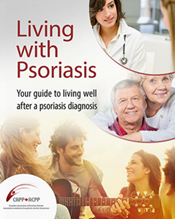Psoriasis affects many different people in many different ways. It is impossible to predict how it will affect you.
Psoriasis symptoms can be mild, moderate or even disabling, especially for psoriasis patients who develop psoriatic (pronounced so-ree-AH-tik) arthritis, which causes painful joints, inflammatory eye conditions and pitted, discoloured nails. Psoriasis tends to go through cycles, flaring for a few weeks or months and then disappearing. Sometimes psoriasis goes into remission, but most of the time it returns.
The classic symptoms of psoriasis are raised, red patches of skin covered with loose, silvery scales. Other signs and symptoms include:
- Tiny bleeds where skin scales are flaked or scraped off
- Itchy skin, particularly during sudden outbreaks or when psoriasis appears in skin folds
- Nail problems, such as tiny pits, yellowish colouring, build-up of dead skin under nails, nail dislodging or falling off
- Scalp scaling or lesions
- Similar patches of psoriasis on both sides of the body
- Appearance of psoriasis about two weeks after a skin injury such as a cut, scrape or sunburn (this is called Koebner’s phenomenon)
There are five types of psoriasis, identified by the presence of different types of psoriatic lesions. Usually, only one type of psoriasis appears at a time, but some people get different types at the same time. Sometimes, after one type of psoriasis clears, another type occurs. Or, one type of psoriasis may transform into another after exposure to a trigger, such as stopping certain psoriasis medications abruptly.
Plaque psoriasis
About 80% to 90% of people have plaque psoriasis. It is the most common type of psoriasis. Here’s what to look for:
- Well-defined, irregularly shaped, sharply outlined, swollen, dry, red, itchy, painful skin lesions—called plaques—with silvery scales on top
- Lesions tend to be distributed symetrically (that is, on both left and right sides of the body)
- Diameter of lesions can vary from 1 cm to several centimetres
- If scratched or scraped away, pinpoints of blood appear underneath lesions Appearance anywhere on the body, but most often on the scalp, torso, buttocks, elbows and knees. Can also include genitals, low back, palms of hands, soles of feet and inside of the mouth.
- The condition frequently affects fingernails and toenails, causing them to develop tiny pits or grooves, change in colour or detach from the underlying nail bed. The nails can also thicken.
- Swollen skin at joint lines or on the palms. Soles may crack and bleed.
Guttate psoriasis
The second most common type of psoriasis, guttate psoriasis, is more common in children and young adults under 30 years of age. It often starts suddenly and is often triggered by a bacterial infection such as strep throat or tonsillitis, skin injuries, stress or certain medications. Guttate psoriasis affects about 10% of people with psoriasis. It is sometimes followed by the development of plaque psoriasis, or it can be an exacerbation of plaque psoriasis.
Distinct, small (1 to 10 mm in diameter), droplet-shaped, reddish spots—often numbering in the hundreds—usually appear on the torso, arms and legs and sometimes on the scalp, ears and face. A fine scale, which is usually thinner than plaques, covers the spots.
Inverse psoriasis
This type of psoriasis mainly affects the skin in the armpits, groin, under the breasts, between the buttocks and around the genitals. Located in skin folds and on sensitive skin, it is easily worsened by rubbing and sweating. (It is also known as flexural psoriasis because it affects sites where the body regularly folds.) It is common in overweight people and people with deep skin folds. It can occur on its own but usually appears along with plaque psoriasis.
The classic signs of inverse psoriasis are smooth, shiny patches of very red, swollen skin.
Pustular psoriasis
Pustular psoriasis is rare and can be severe. It occurs in two forms: localized palmoplantar pustulosis, which affects the palms of the hands and soles of the feet, and generalized pustular psoriasis, which affects large areas of the body. People with widespread patches need to go to the hospital for treatment, as their condition can be life-threatening. It can cause fever, chills, severe itchiness, dehydration, rapid pulse, anemia, exhaustion, weight loss and muscle weakness.
Generally, pustular psoriasis occurs rapidly. First, the skin gets red and tender, then white pus-filled blisters erupt a few hours later. The pus, which is made up of white blood cells, is not an infection and does not spread psoriasis from one person to another.
The blisters dry up, forming scales, in a few days, but they tend to go in a cycle—reappearing every few days or weeks.
Triggers include infections, stress, certain medications, injury to the skin, cold weather, metal allergies, smoking and heavy alcohol consumption.
Erythrodermic psoriasis
Erythrodermic psoriasis (also known as exfoliative psoriasis or psoriatic exfoliative erythroderma) is the least common and most severe type of psoriasis. It covers the body with red, scaly, peeling lesions that can cover the entire body, including eyes, lining of the mouth and inside of the nose. It can itch and burn intensely. The skin swells and sheds multiple layers, often in large sheets. It is more common in men than in women.
Erythrodermic psoriasis may happen once or more often in the lifetime of 1% to 2% of people with psoriasis. It may happen gradually in a person with unstable plaque psoriasis or suddenly in someone who has never had psoriasis. It can be triggered by:
- Severe sunburn
- Underlying cancer
- Corticosteroids and other medications
- Infection
- Alcoholism
- Drug-induced allergic rash
- Abrupt withdrawal of systemic medication
This type of psoriasis may be life-threatening and may require hospitalization. The loss of large areas of skin disrupts the body’s chemistry and may lead to severe illness, such as infection, pneumonia and congestive heart failure. It may raise the heart rate and cause problems with maintaining normal body temperature and fluid levels. Fever is common.



 About the contest
About the contest



